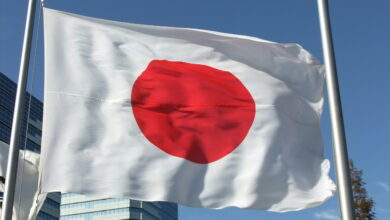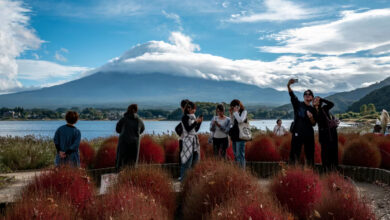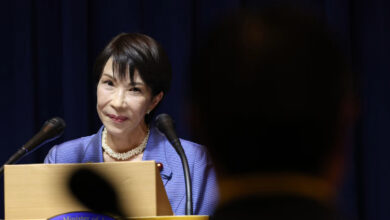RIKUZENTAKATA, Japan — Through silence and prayers, people across Japan on Sunday remembered the massive earthquake and tsunami that struck the nation one year ago, killing just over 19,000 people and unleashing the world's worst nuclear crisis in a quarter century.
In the devastated northeastern coastal town of Rikuzentakata, a siren sounded at 2:46 pm — the exact time the magnitude-9.0 quake struck on 11 March, 2011 — and a Buddhist priest in a purple robe rang a huge bell at a damaged temple overlooking a barren area where houses once stood.
At the same time in the seaside town of Onagawa, people facing the sea pressed their hands together in silent prayer.
Meanwhile, at a memorial service in Tokyo's National Theater, 78-year-old Emperor Akihito, Empress Michiko and Prime Minister Yoshihiko Noda stood in silence with hundreds of other people dressed in black.
Even in Tokyo's busy shopping district of Shibuya, pedestrians briefly stopped and fell silent before carrying on.
Noda recalled in a speech that the Japanese people have overcome disasters and difficulties many times in the past, and pledged to rebuild the nation and the area around the tsunami-stricken Fukushima nuclear plant so that the country will be "reborn as even a better place."
"Our predecessors who had bought prosperity to Japan have repeatedly rose up from the crisis, every time becoming stronger," Noda said. "We will stand by the people from the disaster-hit areas and join hands to achieve this historic task to rebuild."
The earthquake was the strongest recorded in Japan's history, and set off a tsunami that swelled to more than 65 feet (20 meters) in some spots along the northeastern coast, destroying tens of thousands of homes and wreaking widespread destruction.
The tsunami also knocked out the vital cooling systems at the Fukushima Dai-ichi nuclear power plant, causing meltdowns at three reactors and spewing radiation into the air. Some 100,000 residents who were forced to flee remain in temporary housing or with relatives, and a 12-mile (20-kilometer) area around the plant is still off-limits.
The emperor voiced concern about the difficulties of decontaminating radiated land around the plant so that people can live there again.
"In order to make the area inhabitable again, we face the difficult problem of removing radiation," Akihito said in a brief address. "We shall not let our memory of the disasters fade, pay attention to disaster prevention and continue our effort to make this land even a safer place to live."
Naomi Fujino, a 42-year-old Rikuzentakata resident who lost her father in the tsunami, tearfully recalled last 11 March.
With her mother, she had escaped to a nearby hill, where they watched the enormous wave wash away their home. They waited all night, but her father never came to meet them as he had promised. Two months later, his body was found.
"I wanted to save people, but I couldn't. I couldn't even help my father. I cannot keep on crying," Fujino said. "What can I do but keep on going?"
All told, some 325,000 people rendered homeless or evacuated are still in temporary housing. While much of the debris along the tsunami-ravaged coast has been gathered into massive piles, very little rebuilding has begun.
Beyond the massive cleanup, many towns are still finalizing reconstruction plans, some of which involve moving residential areas to higher, safer ground — ambitious, costly projects. Bureaucratic delays in coordination between the central government, prefectural (state) authorities and local officials have also slowed rebuilding efforts.
Anti-nuclear protesters at a downtown Tokyo park also held a moment of silence Sunday before marching toward the headquarters of Tokyo Electric Power Co., the operator of the Fukushima nuclear power plant. Public opposition to atomic power has grown in the wake of the nuclear disaster, the worst since Chernobyl in 1986.
The government says the crippled Fukushima plant is stable and that radiation has subsided significantly, but the plant's chief acknowledged to journalists visiting the complex recently that it remains in a fragile state, and makeshift equipment — some mended with tape — could be seen keeping crucial systems running.
Enormous risks and challenges lie ahead at the plant, including locating and removing melted nuclear fuel from the inside of the reactors and disposing of spent fuel rods. Completely decommissioning the plant could take 40 years.
Only two of Japan's 54 reactors are now running while those shut down for regular inspections undergo special tests to check their ability to withstand similar disasters. They could all go offline by the end of April amid local opposition to restarting them.
The Japanese government has pledged to reduce reliance on nuclear power, which supplied about 30 percent of the nation's energy needs before the disaster, but says it needs to restart some nuclear plants during the transition period.
Authorities say no one has died from radiation exposure, but residents are worried the radiation might show up as cancer in coming years. However, scientists say there is no clear evidence of increased cancer risk from the estimated amount of radiation Fukushima residents have been exposed to, although the health impact of low-dose radiation remains uncertain.
Pilot efforts to make radiation-contaminated land around the plant inhabitable again have begun, using everything from shovels and high-powered water guns to chemicals that absorb radiation.
Prime Minister Noda has acknowledged failures in the government's response to the disaster, being too slow in relaying key information and believing too much in "a myth of safety" about nuclear power.
In Rikuzentakata, 37-year-old Mika Hashikai, who lost both her parents in the tsunami, went around Sunday leaving flowers at the former homes of her friends and neighbors. Her brother also lost his wife and daughter in the tsunami.
"I only wish for my brother's happiness now that he's lost everything and is alone," she said. "Maybe one day he can remarry and have children again."




